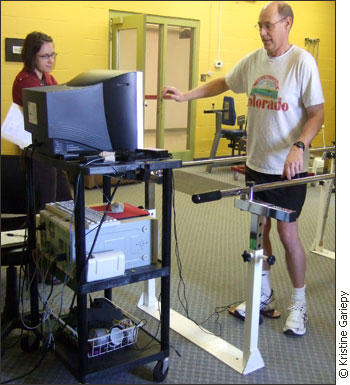 |
| A patient balances on the NeuroGym Trainer while a therapist watches his progress. |
On Oct. 22, 2005, his life changed forever. Savage laced up that night for the University of Moncton Blue Eagles in front of a home crowd.
Then tragedy struck. The former Ottawa 67s player went head first into the boards. He broke his C4 and C5 vertebrae. This injury caused paralysis from the chest down.
Doctors were not sure if he would ever be able to move his arms again.
But Savage would not let this discourage him.
“I started to squeeze hands and slightly move them within a few weeks after my injury,” he says.
By January 2006, Savage was back in Ottawa and began rehab at the NeuroGym, located at Bank and Heron. As part of his exercise regime, Savage, now 28, uses the Nintendo Wii. It has been incorporated into his training to help build arm strength.
“I do [Wii] boxing for endurance conditioning,” he says. “It is usually an exercise I do right at the end of my rehabilitation session.”
The Wii goes medical
Avi Nativ is the president of NeuroGym and the inventor of the NeuroGym Trainer. He has helped hundreds of patients like Savage with neurological injuries. He has developed what he calls the medical Wii, which he is starting to promote across North America.
The NeuroGym Trainer offers either foot paddles or hand sensing technology that is attached to a computer. These sensors then control a basic game that is displayed on the computer screen in front of them. His patients play games similar to Pong, where a ball falls down toward a moving bar across the bottom of the screen that is controlled by the patient.
Control and coordination can be addressed with both machines says Nativ. Balance with the NeuroGym Trainer and coordination with the Wii, he says.
Nativ says that when motion is repeated, changes in the brain begin to occur. This allows patients to connect with the games they are playing and build strength with them. The games build coordination, concentration and muscle strength among participants.
| “We knew Wii would get people moving, but did not anticipate all the great ways that people are finding to have fun with the system,” says Nintendo of America. |
The NeuroGym offers patients many different rehab machines for patient treatments; from basic injuries to chronic conditions of the hands, legs or feet.
All the machines provide treatments to improve mobility in seniors and also to patients who are being treated for neurological disorders and injuries.
“Typically neurological injuries are slow to respond,” he says. “We are starting to use speed-sensitive biofeedback tools, which allows trainers to amplify or intensify therapy.”
The Wii has also been integrated into treatment programs at Glenrose Rehabilitation Hospital in Edmonton, Alta. It was the first facility in North American to offer it with treatment. Occupational Therapist Evelyn Ching says the Wii is beneficial.
“A person could be doing weights and ranged motion exercises but we also use the Wii for functional, goal-directed movements,” she says.
Nintendo never anticipated the rapid success of Wii Fit and Wii Sports being used in rehabilitation facilities.
“We knew Wii would get people moving, but did not anticipate all the great ways that people are finding to have fun with the system,” says Nintendo of America in an email response.
Video Games Engage Patients
The director of Rutgers University Tele-Rehabilitation Institute, Greg Burdea says he believes the Wii has started the new trend toward video games as useful tools for patients.
“The advantage of using a video game is it makes and engages the patient, it makes them do what the therapist wants them to do without realizing it,” he says.
However, Burdea says that the effects of playing too much Wii can actually be bad for your health. ‘Wiitus’ is a medical term and occurs with repetitive play over extended periods of time.
Back in Ottawa, Savage continues to see progress in his arm strength through his rehabilitation, he sees the Wii as a powerful home tool for people with injuries.
“It adds some variety and a lot more fun,” he says. “Adding on to a simple video game for people who are unable to move around, it will be good.”
The future of rehabilitation and video games is promising with recreational tools like the Wii getting ordinary people out of their chairs, and medical devices like the NeuroGym Trainer. Five years from now could bring big changes in home rehab as well as other recreational options to recover from injuries or disorders.
|

